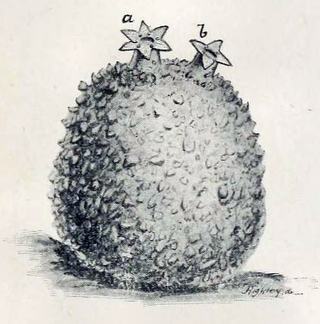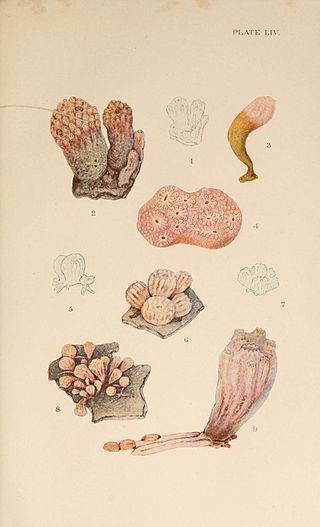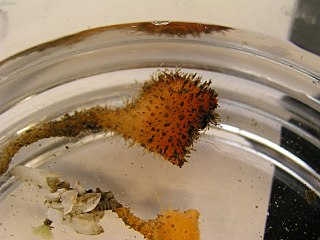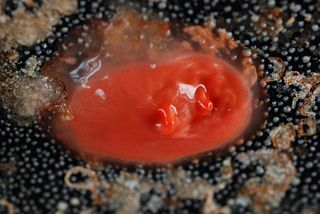
A tunicate is an exclusively marine invertebrate animal, a member of the subphylum Tunicata. This grouping is part of the Chordata, a phylum which includes all animals with dorsal nerve cords and notochords. The subphylum was at one time called Urochordata, and the term urochordates is still sometimes used for these animals. They are the only chordates that have lost their myomeric segmentation, with the possible exception of the seriation of the gill slits. However, doliolids still display segmentation of the muscle bands.

Ascidiacea, commonly known as the ascidians or sea squirts, is a paraphyletic class in the subphylum Tunicata of sac-like marine invertebrate filter feeders. Ascidians are characterized by a tough outer "tunic" made of a polysaccharide.

Corella willmeriana is a solitary tunicate in the family Corellidae. It is native to the eastern Pacific Ocean where it lives on the seabed at depths down to about 75 m (250 ft) between Alaska and California.

Atriolum robustum is a colonial tunicate or sea squirt in the family Didemnidae. It is native to the western and central Indo-Pacific where it is usually found anchored to a hard surface in shallow water.

Didemnum molle is a species of colonial tunicate in the family Didemnidae. It is commonly known as the tall urn ascidian, the green barrel sea squirt or the green reef sea-squirt. It is native to the Red Sea and the tropical waters of the Indo-Pacific region.

Didemnum vexillum is a species of colonial tunicate in the family Didemnidae. It is commonly called sea vomit, marine vomit, pancake batter tunicate, or carpet sea squirt. It is thought to be native to Japan, but it has been reported as an invasive species in a number of places in Europe, North America and New Zealand. It is sometimes given the nickname "D. vex" because of the vexing way in which it dominates marine ecosystems when introduced into new locations; however, the species epithet vexillum actually derives from the Latin word for flag, and the species was so named because of the way colonies' long tendrils appear to wave in the water like a flag.

Ciona savignyi is a marine animal sometimes known as the Pacific transparent sea squirt or solitary sea squirt. It is a species of tunicates in the family Cionidae. It is found in shallow waters around Japan and has spread to the west coast of North America where it is regarded as an invasive species.
Perophora viridis, the honeysuckle tunicate, is a species of colonial sea squirt in the genus Perophora found in the tropical western Atlantic Ocean.

Molgula oculata, commonly known as the sea grape, is a species of solitary tunicate in the family Molgulidae. It is native to the north eastern Atlantic Ocean and the North Sea. The specific name oculata means "having eyes"; the species has orifices which "seem like dark eyes within a spectacle-formed frame".
Molgula occulta is a species of solitary tunicate in the family Molgulidae. It is native to the north eastern Atlantic Ocean, the North Sea and the Mediterranean Sea. The specific name occulta means "tailless" and refers to the tunicate's larva, which lacks the tail found in some other species in the genus Molgula.
Polycarpa fibrosa is a species of tunicate in the family Styelidae. It is brown and globular and its outer surface is covered with a mat of fibrils. It normally lies buried in soft sediment on the seabed with only its two siphons protruding. It occurs in the Arctic Ocean and northern Atlantic Ocean. P. fibrosa was first identified and described by the American malacologist William Stimpson in 1852.

Morchellium argus, the red-flake ascidian, is a species of colonial sea squirt, a tunicate in the family Polyclinidae. It is native to shallow water in the northeastern Atlantic Ocean, especially round the coasts of Britain.

Polycarpa pomaria is a species of tunicate or sea squirt in the family Styelidae. It is native to the northeastern Atlantic Ocean where it lives on the seabed at depths down to about 450 metres (1,500 ft).

Phallusia mammillata is a solitary marine tunicate of the ascidian class found in the eastern Atlantic Ocean and the Mediterranean Sea.

Molgula manhattensis, commonly known as "sea grapes", is a species of ascidian commonly found along the East Coast and Gulf Coast region of the United States. Although it is native to this region, it has been introduced to other areas of Europe, Australia, and the West Coast.

Molgula occidentalis is a species of marine invertebrate of the family Molgulidae. The scientific name of the species was validated and published for the first time in 1883 by Traustedt. It is a soft-bodied, intertidal ascidian, sac-like filter feeders in the subphylum tunicate characterized by a hard outer covering known as a “tunic,” abundant in the shallow subtidal and intertidal zones of the Northern Gulf of Mexico, where they establish pseudopopulations.

Boltenia villosa is a species of tunicate, a marine invertebrate of the family Pyuridae. Common names include spiny-headed tunicate, hairy sea squirt, stalked hairy sea squirt and bristly tunicate. This species was first described in 1864 by the American marine biologist William Stimpson who gave it the name Cynthia villosa. It was later transferred to the genus Boltenia. The type locality is Puget Sound, Washington state, United States.

Cnemidocarpa finmarkiensis is a species of solitary ascidian tunicate in the family Styelidae. Common names include broad base sea squirt, orange sea squirt, red sea squirt, shiny orange sea squirt, shiny red tunicate and Finmark's tunicate. It is native to shallow waters in the northern and northeastern Pacific Ocean.

Pyura haustor is a species of sessile ascidian, or sea squirt, that lives in coastal waters in the north-eastern Pacific Ocean, attached to rocks or artificial structures. Common names for this species include the wrinkled seapump, the wrinkled sea squirt and the warty tunicate.

Halocynthia igaboja, commonly known as sea hedgehog, bristly tunicate or spiny sea squirt, is a species of tunicate in the family Pyuridae. It is native to the northeastern Pacific Ocean. This species was first described in 1906 by the Japanese marine biologist Asajiro Oka, who gave it the name Cynthia ritteri. It was later transferred to the genus Halocynthia.
















